Who Benefitted from Women's Modernization in India After Independence?
VerifiedAdded on 2023/01/12
|10
|3214
|61
Essay
AI Summary
This essay investigates the beneficiaries of women's modernization in India following independence, focusing on the multifaceted impacts of social and political changes on various segments of society. It examines how middle-class women experienced shifts in their roles, opportunities, and societal recognition, including increased participation in education and the workforce. The essay also explores the effects of modernization on women workers, particularly in industries such as coal plants, highlighting the role of government legislation in improving their working conditions and rights. Furthermore, it analyzes the government's involvement in promoting women's rights and empowerment through policy, political representation, and social welfare programs. Through a review of primary sources and historiography, the essay provides a comprehensive analysis of the complex and varied consequences of modernization on Indian women's lives, considering both the progress achieved and the challenges that persisted.
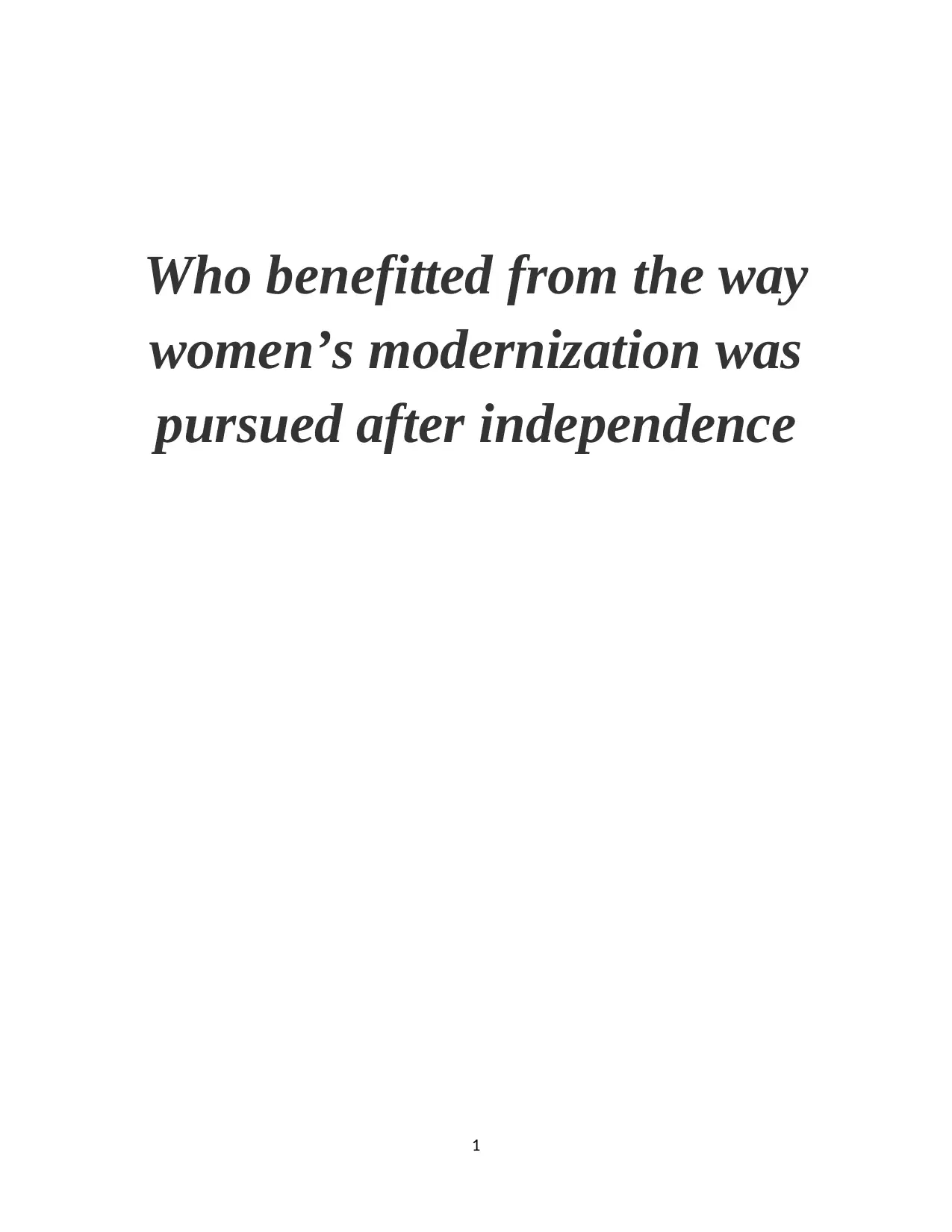
Who benefitted from the way
women’s modernization was
pursued after independence
1
women’s modernization was
pursued after independence
1
Paraphrase This Document
Need a fresh take? Get an instant paraphrase of this document with our AI Paraphraser
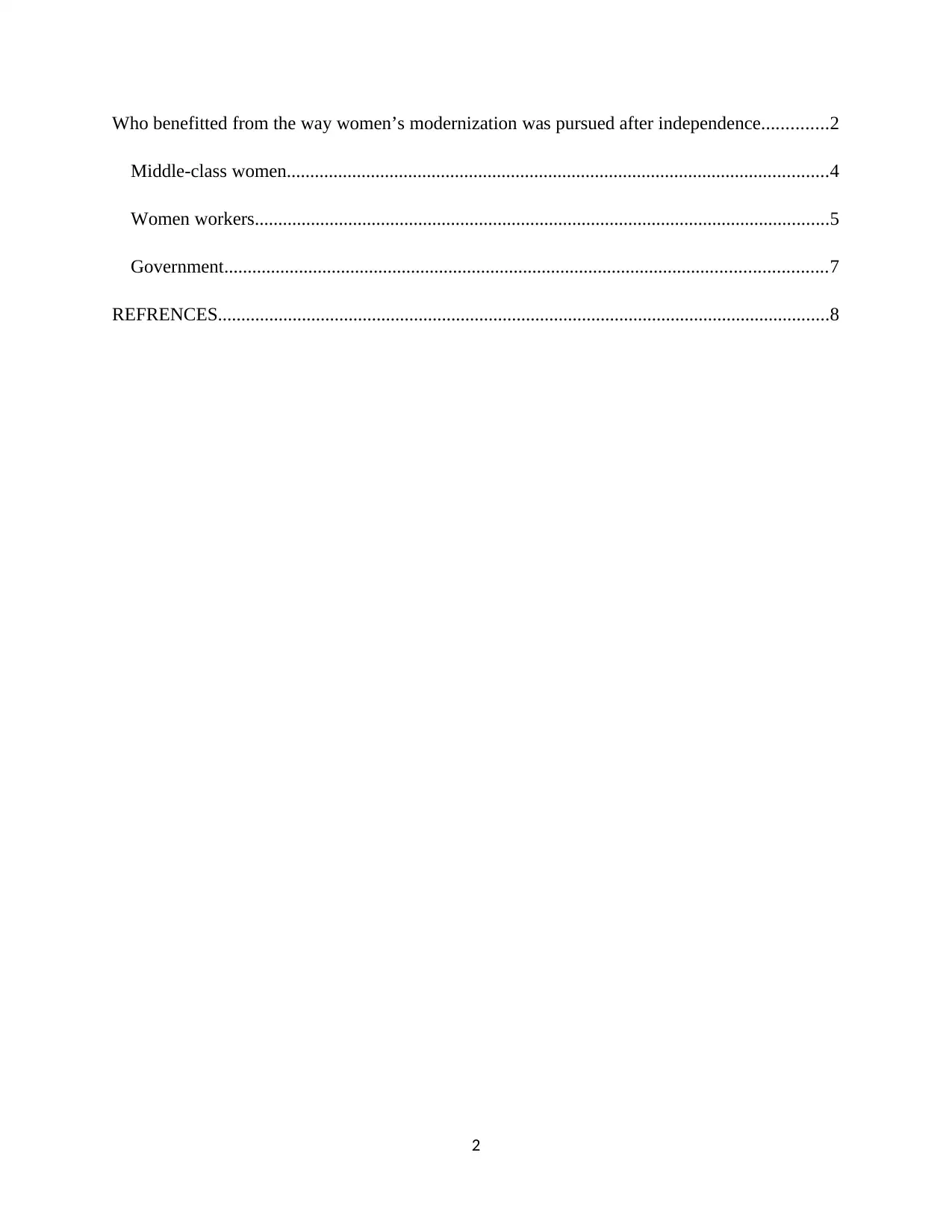
Who benefitted from the way women’s modernization was pursued after independence..............2
Middle-class women....................................................................................................................4
Women workers...........................................................................................................................5
Government.................................................................................................................................7
REFRENCES...................................................................................................................................8
2
Middle-class women....................................................................................................................4
Women workers...........................................................................................................................5
Government.................................................................................................................................7
REFRENCES...................................................................................................................................8
2
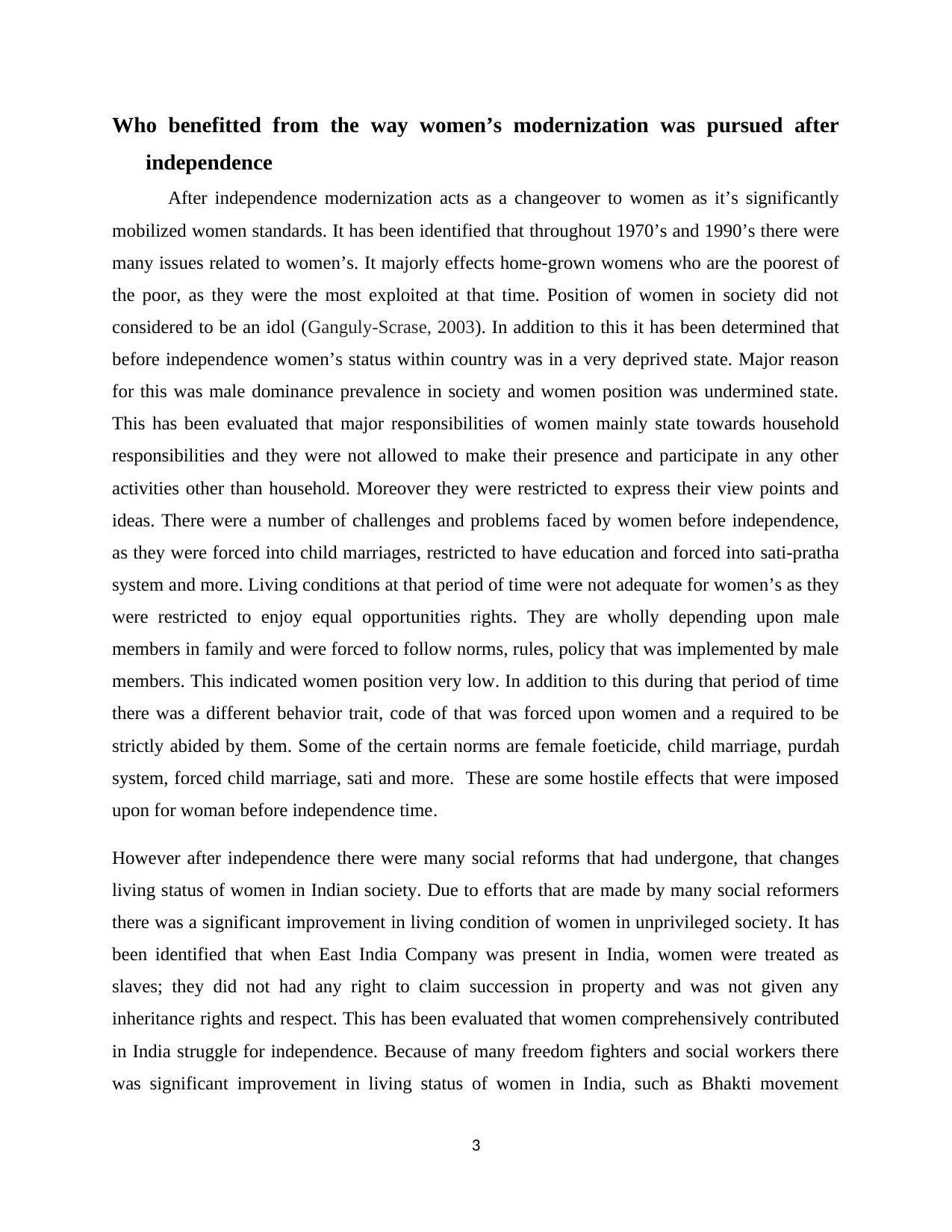
Who benefitted from the way women’s modernization was pursued after
independence
After independence modernization acts as a changeover to women as it’s significantly
mobilized women standards. It has been identified that throughout 1970’s and 1990’s there were
many issues related to women’s. It majorly effects home-grown womens who are the poorest of
the poor, as they were the most exploited at that time. Position of women in society did not
considered to be an idol (Ganguly-Scrase, 2003). In addition to this it has been determined that
before independence women’s status within country was in a very deprived state. Major reason
for this was male dominance prevalence in society and women position was undermined state.
This has been evaluated that major responsibilities of women mainly state towards household
responsibilities and they were not allowed to make their presence and participate in any other
activities other than household. Moreover they were restricted to express their view points and
ideas. There were a number of challenges and problems faced by women before independence,
as they were forced into child marriages, restricted to have education and forced into sati-pratha
system and more. Living conditions at that period of time were not adequate for women’s as they
were restricted to enjoy equal opportunities rights. They are wholly depending upon male
members in family and were forced to follow norms, rules, policy that was implemented by male
members. This indicated women position very low. In addition to this during that period of time
there was a different behavior trait, code of that was forced upon women and a required to be
strictly abided by them. Some of the certain norms are female foeticide, child marriage, purdah
system, forced child marriage, sati and more. These are some hostile effects that were imposed
upon for woman before independence time.
However after independence there were many social reforms that had undergone, that changes
living status of women in Indian society. Due to efforts that are made by many social reformers
there was a significant improvement in living condition of women in unprivileged society. It has
been identified that when East India Company was present in India, women were treated as
slaves; they did not had any right to claim succession in property and was not given any
inheritance rights and respect. This has been evaluated that women comprehensively contributed
in India struggle for independence. Because of many freedom fighters and social workers there
was significant improvement in living status of women in India, such as Bhakti movement
3
independence
After independence modernization acts as a changeover to women as it’s significantly
mobilized women standards. It has been identified that throughout 1970’s and 1990’s there were
many issues related to women’s. It majorly effects home-grown womens who are the poorest of
the poor, as they were the most exploited at that time. Position of women in society did not
considered to be an idol (Ganguly-Scrase, 2003). In addition to this it has been determined that
before independence women’s status within country was in a very deprived state. Major reason
for this was male dominance prevalence in society and women position was undermined state.
This has been evaluated that major responsibilities of women mainly state towards household
responsibilities and they were not allowed to make their presence and participate in any other
activities other than household. Moreover they were restricted to express their view points and
ideas. There were a number of challenges and problems faced by women before independence,
as they were forced into child marriages, restricted to have education and forced into sati-pratha
system and more. Living conditions at that period of time were not adequate for women’s as they
were restricted to enjoy equal opportunities rights. They are wholly depending upon male
members in family and were forced to follow norms, rules, policy that was implemented by male
members. This indicated women position very low. In addition to this during that period of time
there was a different behavior trait, code of that was forced upon women and a required to be
strictly abided by them. Some of the certain norms are female foeticide, child marriage, purdah
system, forced child marriage, sati and more. These are some hostile effects that were imposed
upon for woman before independence time.
However after independence there were many social reforms that had undergone, that changes
living status of women in Indian society. Due to efforts that are made by many social reformers
there was a significant improvement in living condition of women in unprivileged society. It has
been identified that when East India Company was present in India, women were treated as
slaves; they did not had any right to claim succession in property and was not given any
inheritance rights and respect. This has been evaluated that women comprehensively contributed
in India struggle for independence. Because of many freedom fighters and social workers there
was significant improvement in living status of women in India, such as Bhakti movement
3
⊘ This is a preview!⊘
Do you want full access?
Subscribe today to unlock all pages.

Trusted by 1+ million students worldwide
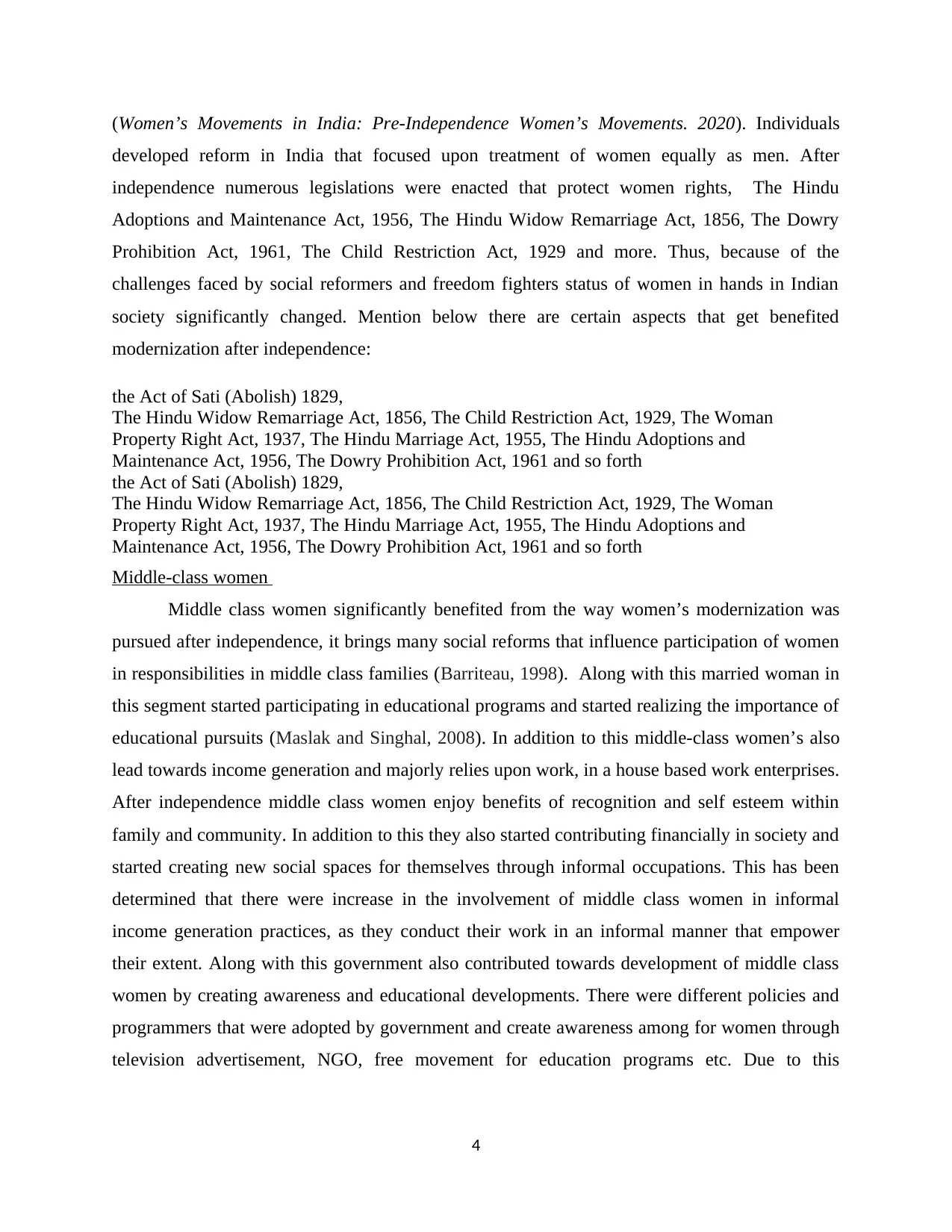
(Women’s Movements in India: Pre-Independence Women’s Movements. 2020). Individuals
developed reform in India that focused upon treatment of women equally as men. After
independence numerous legislations were enacted that protect women rights, The Hindu
Adoptions and Maintenance Act, 1956, The Hindu Widow Remarriage Act, 1856, The Dowry
Prohibition Act, 1961, The Child Restriction Act, 1929 and more. Thus, because of the
challenges faced by social reformers and freedom fighters status of women in hands in Indian
society significantly changed. Mention below there are certain aspects that get benefited
modernization after independence:
the Act of Sati (Abolish) 1829,
The Hindu Widow Remarriage Act, 1856, The Child Restriction Act, 1929, The Woman
Property Right Act, 1937, The Hindu Marriage Act, 1955, The Hindu Adoptions and
Maintenance Act, 1956, The Dowry Prohibition Act, 1961 and so forth
the Act of Sati (Abolish) 1829,
The Hindu Widow Remarriage Act, 1856, The Child Restriction Act, 1929, The Woman
Property Right Act, 1937, The Hindu Marriage Act, 1955, The Hindu Adoptions and
Maintenance Act, 1956, The Dowry Prohibition Act, 1961 and so forth
Middle-class women
Middle class women significantly benefited from the way women’s modernization was
pursued after independence, it brings many social reforms that influence participation of women
in responsibilities in middle class families (Barriteau, 1998). Along with this married woman in
this segment started participating in educational programs and started realizing the importance of
educational pursuits (Maslak and Singhal, 2008). In addition to this middle-class women’s also
lead towards income generation and majorly relies upon work, in a house based work enterprises.
After independence middle class women enjoy benefits of recognition and self esteem within
family and community. In addition to this they also started contributing financially in society and
started creating new social spaces for themselves through informal occupations. This has been
determined that there were increase in the involvement of middle class women in informal
income generation practices, as they conduct their work in an informal manner that empower
their extent. Along with this government also contributed towards development of middle class
women by creating awareness and educational developments. There were different policies and
programmers that were adopted by government and create awareness among for women through
television advertisement, NGO, free movement for education programs etc. Due to this
4
developed reform in India that focused upon treatment of women equally as men. After
independence numerous legislations were enacted that protect women rights, The Hindu
Adoptions and Maintenance Act, 1956, The Hindu Widow Remarriage Act, 1856, The Dowry
Prohibition Act, 1961, The Child Restriction Act, 1929 and more. Thus, because of the
challenges faced by social reformers and freedom fighters status of women in hands in Indian
society significantly changed. Mention below there are certain aspects that get benefited
modernization after independence:
the Act of Sati (Abolish) 1829,
The Hindu Widow Remarriage Act, 1856, The Child Restriction Act, 1929, The Woman
Property Right Act, 1937, The Hindu Marriage Act, 1955, The Hindu Adoptions and
Maintenance Act, 1956, The Dowry Prohibition Act, 1961 and so forth
the Act of Sati (Abolish) 1829,
The Hindu Widow Remarriage Act, 1856, The Child Restriction Act, 1929, The Woman
Property Right Act, 1937, The Hindu Marriage Act, 1955, The Hindu Adoptions and
Maintenance Act, 1956, The Dowry Prohibition Act, 1961 and so forth
Middle-class women
Middle class women significantly benefited from the way women’s modernization was
pursued after independence, it brings many social reforms that influence participation of women
in responsibilities in middle class families (Barriteau, 1998). Along with this married woman in
this segment started participating in educational programs and started realizing the importance of
educational pursuits (Maslak and Singhal, 2008). In addition to this middle-class women’s also
lead towards income generation and majorly relies upon work, in a house based work enterprises.
After independence middle class women enjoy benefits of recognition and self esteem within
family and community. In addition to this they also started contributing financially in society and
started creating new social spaces for themselves through informal occupations. This has been
determined that there were increase in the involvement of middle class women in informal
income generation practices, as they conduct their work in an informal manner that empower
their extent. Along with this government also contributed towards development of middle class
women by creating awareness and educational developments. There were different policies and
programmers that were adopted by government and create awareness among for women through
television advertisement, NGO, free movement for education programs etc. Due to this
4
Paraphrase This Document
Need a fresh take? Get an instant paraphrase of this document with our AI Paraphraser
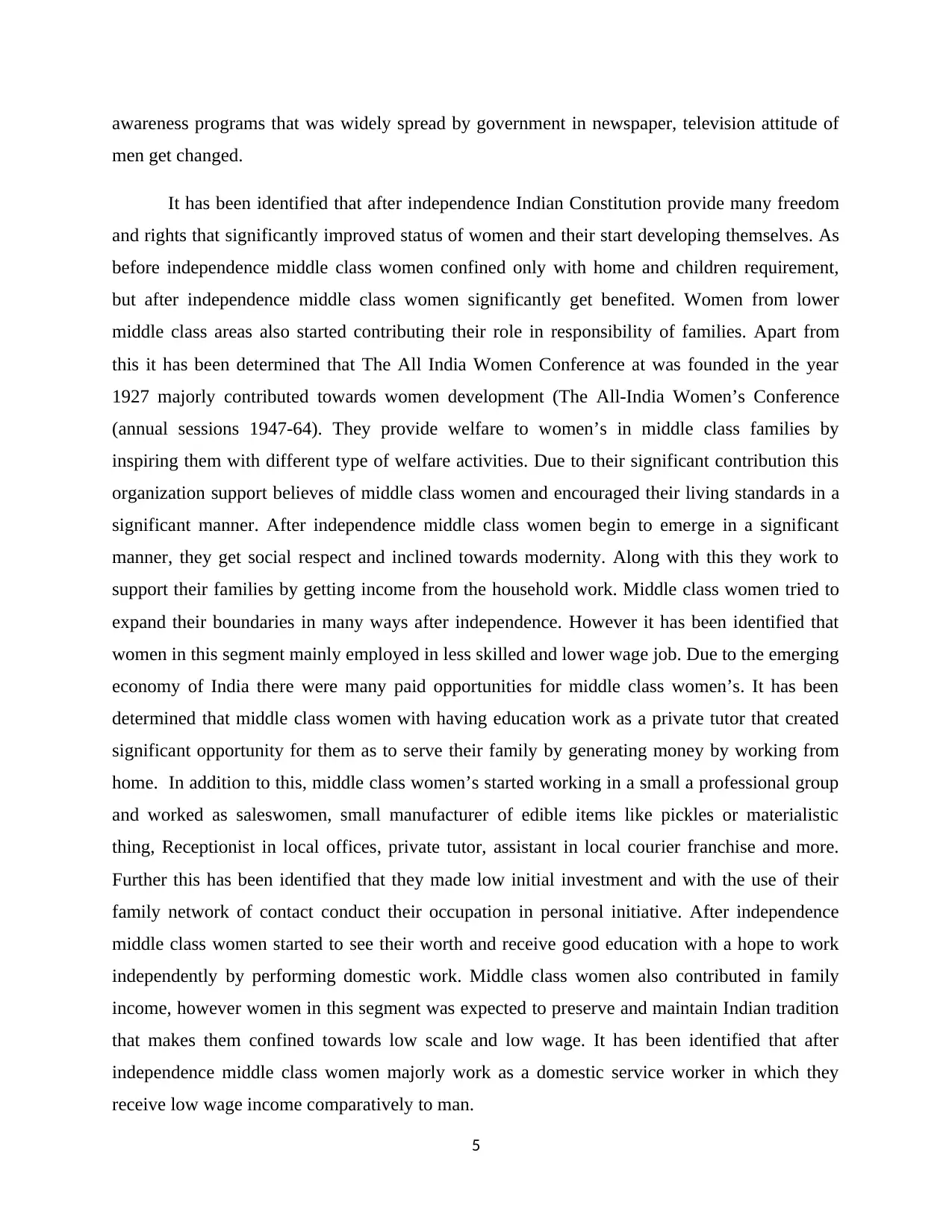
awareness programs that was widely spread by government in newspaper, television attitude of
men get changed.
It has been identified that after independence Indian Constitution provide many freedom
and rights that significantly improved status of women and their start developing themselves. As
before independence middle class women confined only with home and children requirement,
but after independence middle class women significantly get benefited. Women from lower
middle class areas also started contributing their role in responsibility of families. Apart from
this it has been determined that The All India Women Conference at was founded in the year
1927 majorly contributed towards women development (The All-India Women’s Conference
(annual sessions 1947-64). They provide welfare to women’s in middle class families by
inspiring them with different type of welfare activities. Due to their significant contribution this
organization support believes of middle class women and encouraged their living standards in a
significant manner. After independence middle class women begin to emerge in a significant
manner, they get social respect and inclined towards modernity. Along with this they work to
support their families by getting income from the household work. Middle class women tried to
expand their boundaries in many ways after independence. However it has been identified that
women in this segment mainly employed in less skilled and lower wage job. Due to the emerging
economy of India there were many paid opportunities for middle class women’s. It has been
determined that middle class women with having education work as a private tutor that created
significant opportunity for them as to serve their family by generating money by working from
home. In addition to this, middle class women’s started working in a small a professional group
and worked as saleswomen, small manufacturer of edible items like pickles or materialistic
thing, Receptionist in local offices, private tutor, assistant in local courier franchise and more.
Further this has been identified that they made low initial investment and with the use of their
family network of contact conduct their occupation in personal initiative. After independence
middle class women started to see their worth and receive good education with a hope to work
independently by performing domestic work. Middle class women also contributed in family
income, however women in this segment was expected to preserve and maintain Indian tradition
that makes them confined towards low scale and low wage. It has been identified that after
independence middle class women majorly work as a domestic service worker in which they
receive low wage income comparatively to man.
5
men get changed.
It has been identified that after independence Indian Constitution provide many freedom
and rights that significantly improved status of women and their start developing themselves. As
before independence middle class women confined only with home and children requirement,
but after independence middle class women significantly get benefited. Women from lower
middle class areas also started contributing their role in responsibility of families. Apart from
this it has been determined that The All India Women Conference at was founded in the year
1927 majorly contributed towards women development (The All-India Women’s Conference
(annual sessions 1947-64). They provide welfare to women’s in middle class families by
inspiring them with different type of welfare activities. Due to their significant contribution this
organization support believes of middle class women and encouraged their living standards in a
significant manner. After independence middle class women begin to emerge in a significant
manner, they get social respect and inclined towards modernity. Along with this they work to
support their families by getting income from the household work. Middle class women tried to
expand their boundaries in many ways after independence. However it has been identified that
women in this segment mainly employed in less skilled and lower wage job. Due to the emerging
economy of India there were many paid opportunities for middle class women’s. It has been
determined that middle class women with having education work as a private tutor that created
significant opportunity for them as to serve their family by generating money by working from
home. In addition to this, middle class women’s started working in a small a professional group
and worked as saleswomen, small manufacturer of edible items like pickles or materialistic
thing, Receptionist in local offices, private tutor, assistant in local courier franchise and more.
Further this has been identified that they made low initial investment and with the use of their
family network of contact conduct their occupation in personal initiative. After independence
middle class women started to see their worth and receive good education with a hope to work
independently by performing domestic work. Middle class women also contributed in family
income, however women in this segment was expected to preserve and maintain Indian tradition
that makes them confined towards low scale and low wage. It has been identified that after
independence middle class women majorly work as a domestic service worker in which they
receive low wage income comparatively to man.
5
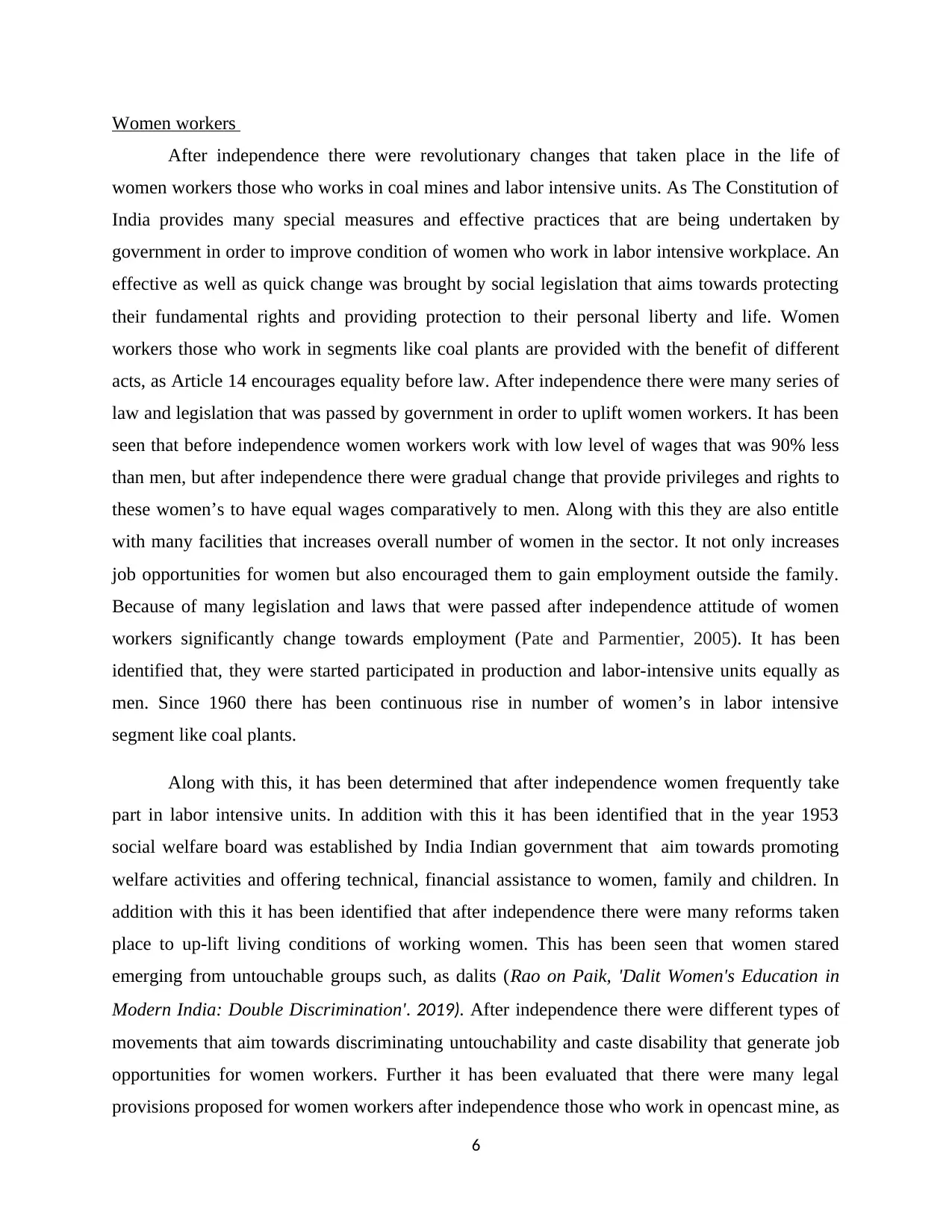
Women workers
After independence there were revolutionary changes that taken place in the life of
women workers those who works in coal mines and labor intensive units. As The Constitution of
India provides many special measures and effective practices that are being undertaken by
government in order to improve condition of women who work in labor intensive workplace. An
effective as well as quick change was brought by social legislation that aims towards protecting
their fundamental rights and providing protection to their personal liberty and life. Women
workers those who work in segments like coal plants are provided with the benefit of different
acts, as Article 14 encourages equality before law. After independence there were many series of
law and legislation that was passed by government in order to uplift women workers. It has been
seen that before independence women workers work with low level of wages that was 90% less
than men, but after independence there were gradual change that provide privileges and rights to
these women’s to have equal wages comparatively to men. Along with this they are also entitle
with many facilities that increases overall number of women in the sector. It not only increases
job opportunities for women but also encouraged them to gain employment outside the family.
Because of many legislation and laws that were passed after independence attitude of women
workers significantly change towards employment (Pate and Parmentier, 2005). It has been
identified that, they were started participated in production and labor-intensive units equally as
men. Since 1960 there has been continuous rise in number of women’s in labor intensive
segment like coal plants.
Along with this, it has been determined that after independence women frequently take
part in labor intensive units. In addition with this it has been identified that in the year 1953
social welfare board was established by India Indian government that aim towards promoting
welfare activities and offering technical, financial assistance to women, family and children. In
addition with this it has been identified that after independence there were many reforms taken
place to up-lift living conditions of working women. This has been seen that women stared
emerging from untouchable groups such, as dalits (Rao on Paik, 'Dalit Women's Education in
Modern India: Double Discrimination'. 2019). After independence there were different types of
movements that aim towards discriminating untouchability and caste disability that generate job
opportunities for women workers. Further it has been evaluated that there were many legal
provisions proposed for women workers after independence those who work in opencast mine, as
6
After independence there were revolutionary changes that taken place in the life of
women workers those who works in coal mines and labor intensive units. As The Constitution of
India provides many special measures and effective practices that are being undertaken by
government in order to improve condition of women who work in labor intensive workplace. An
effective as well as quick change was brought by social legislation that aims towards protecting
their fundamental rights and providing protection to their personal liberty and life. Women
workers those who work in segments like coal plants are provided with the benefit of different
acts, as Article 14 encourages equality before law. After independence there were many series of
law and legislation that was passed by government in order to uplift women workers. It has been
seen that before independence women workers work with low level of wages that was 90% less
than men, but after independence there were gradual change that provide privileges and rights to
these women’s to have equal wages comparatively to men. Along with this they are also entitle
with many facilities that increases overall number of women in the sector. It not only increases
job opportunities for women but also encouraged them to gain employment outside the family.
Because of many legislation and laws that were passed after independence attitude of women
workers significantly change towards employment (Pate and Parmentier, 2005). It has been
identified that, they were started participated in production and labor-intensive units equally as
men. Since 1960 there has been continuous rise in number of women’s in labor intensive
segment like coal plants.
Along with this, it has been determined that after independence women frequently take
part in labor intensive units. In addition with this it has been identified that in the year 1953
social welfare board was established by India Indian government that aim towards promoting
welfare activities and offering technical, financial assistance to women, family and children. In
addition with this it has been identified that after independence there were many reforms taken
place to up-lift living conditions of working women. This has been seen that women stared
emerging from untouchable groups such, as dalits (Rao on Paik, 'Dalit Women's Education in
Modern India: Double Discrimination'. 2019). After independence there were different types of
movements that aim towards discriminating untouchability and caste disability that generate job
opportunities for women workers. Further it has been evaluated that there were many legal
provisions proposed for women workers after independence those who work in opencast mine, as
6
⊘ This is a preview!⊘
Do you want full access?
Subscribe today to unlock all pages.

Trusted by 1+ million students worldwide
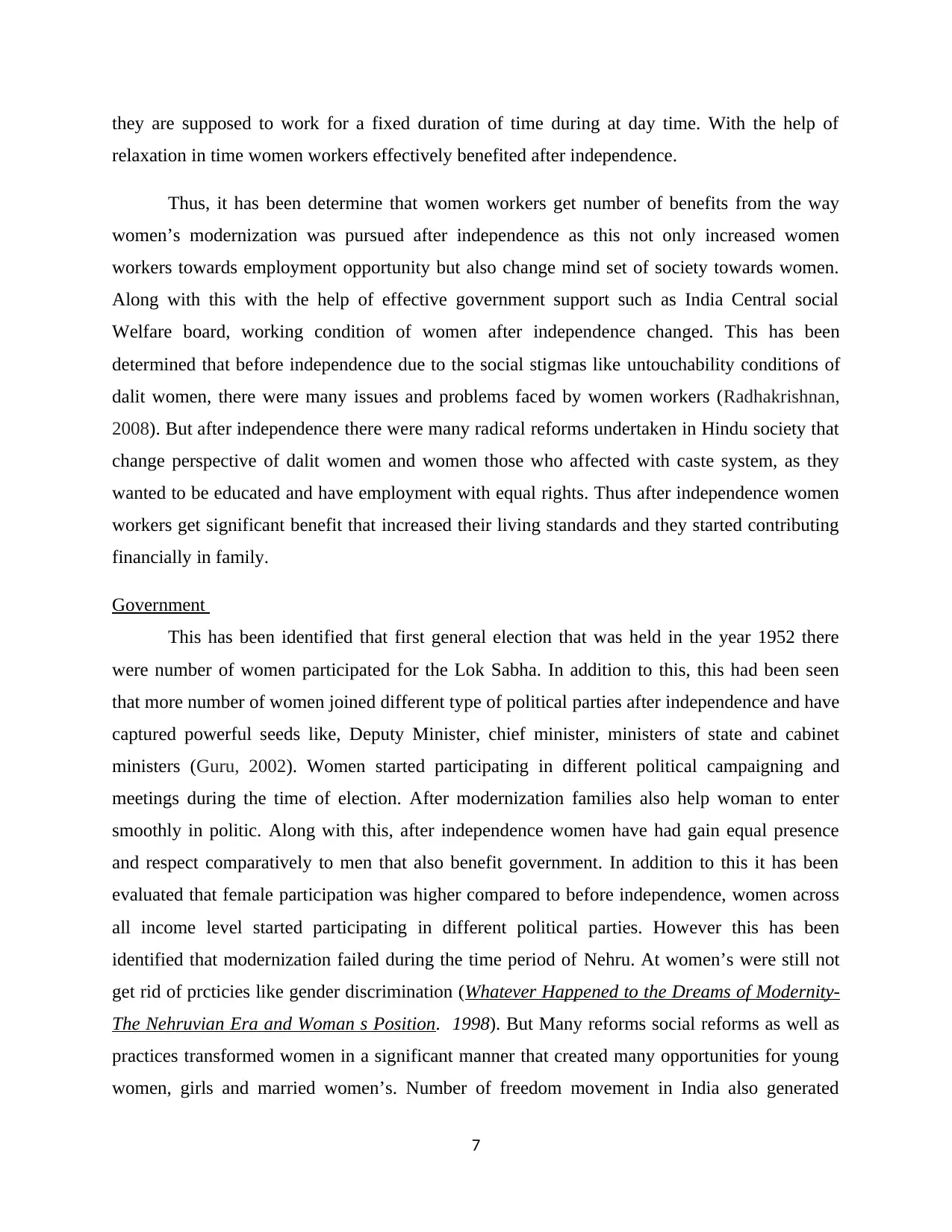
they are supposed to work for a fixed duration of time during at day time. With the help of
relaxation in time women workers effectively benefited after independence.
Thus, it has been determine that women workers get number of benefits from the way
women’s modernization was pursued after independence as this not only increased women
workers towards employment opportunity but also change mind set of society towards women.
Along with this with the help of effective government support such as India Central social
Welfare board, working condition of women after independence changed. This has been
determined that before independence due to the social stigmas like untouchability conditions of
dalit women, there were many issues and problems faced by women workers (Radhakrishnan,
2008). But after independence there were many radical reforms undertaken in Hindu society that
change perspective of dalit women and women those who affected with caste system, as they
wanted to be educated and have employment with equal rights. Thus after independence women
workers get significant benefit that increased their living standards and they started contributing
financially in family.
Government
This has been identified that first general election that was held in the year 1952 there
were number of women participated for the Lok Sabha. In addition to this, this had been seen
that more number of women joined different type of political parties after independence and have
captured powerful seeds like, Deputy Minister, chief minister, ministers of state and cabinet
ministers (Guru, 2002). Women started participating in different political campaigning and
meetings during the time of election. After modernization families also help woman to enter
smoothly in politic. Along with this, after independence women have had gain equal presence
and respect comparatively to men that also benefit government. In addition to this it has been
evaluated that female participation was higher compared to before independence, women across
all income level started participating in different political parties. However this has been
identified that modernization failed during the time period of Nehru. At women’s were still not
get rid of prcticies like gender discrimination (Whatever Happened to the Dreams of Modernity-
The Nehruvian Era and Woman s Position. 1998). But Many reforms social reforms as well as
practices transformed women in a significant manner that created many opportunities for young
women, girls and married women’s. Number of freedom movement in India also generated
7
relaxation in time women workers effectively benefited after independence.
Thus, it has been determine that women workers get number of benefits from the way
women’s modernization was pursued after independence as this not only increased women
workers towards employment opportunity but also change mind set of society towards women.
Along with this with the help of effective government support such as India Central social
Welfare board, working condition of women after independence changed. This has been
determined that before independence due to the social stigmas like untouchability conditions of
dalit women, there were many issues and problems faced by women workers (Radhakrishnan,
2008). But after independence there were many radical reforms undertaken in Hindu society that
change perspective of dalit women and women those who affected with caste system, as they
wanted to be educated and have employment with equal rights. Thus after independence women
workers get significant benefit that increased their living standards and they started contributing
financially in family.
Government
This has been identified that first general election that was held in the year 1952 there
were number of women participated for the Lok Sabha. In addition to this, this had been seen
that more number of women joined different type of political parties after independence and have
captured powerful seeds like, Deputy Minister, chief minister, ministers of state and cabinet
ministers (Guru, 2002). Women started participating in different political campaigning and
meetings during the time of election. After modernization families also help woman to enter
smoothly in politic. Along with this, after independence women have had gain equal presence
and respect comparatively to men that also benefit government. In addition to this it has been
evaluated that female participation was higher compared to before independence, women across
all income level started participating in different political parties. However this has been
identified that modernization failed during the time period of Nehru. At women’s were still not
get rid of prcticies like gender discrimination (Whatever Happened to the Dreams of Modernity-
The Nehruvian Era and Woman s Position. 1998). But Many reforms social reforms as well as
practices transformed women in a significant manner that created many opportunities for young
women, girls and married women’s. Number of freedom movement in India also generated
7
Paraphrase This Document
Need a fresh take? Get an instant paraphrase of this document with our AI Paraphraser
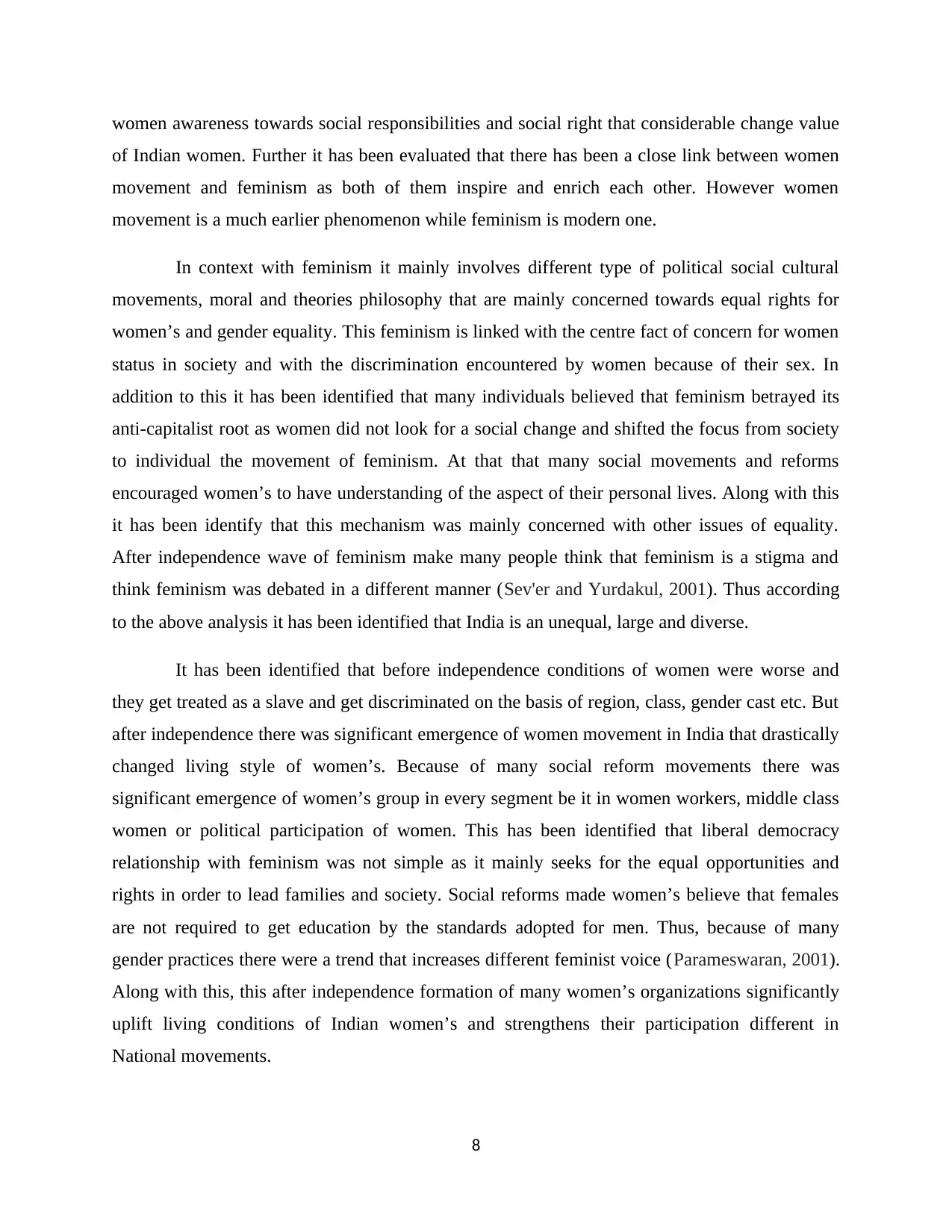
women awareness towards social responsibilities and social right that considerable change value
of Indian women. Further it has been evaluated that there has been a close link between women
movement and feminism as both of them inspire and enrich each other. However women
movement is a much earlier phenomenon while feminism is modern one.
In context with feminism it mainly involves different type of political social cultural
movements, moral and theories philosophy that are mainly concerned towards equal rights for
women’s and gender equality. This feminism is linked with the centre fact of concern for women
status in society and with the discrimination encountered by women because of their sex. In
addition to this it has been identified that many individuals believed that feminism betrayed its
anti-capitalist root as women did not look for a social change and shifted the focus from society
to individual the movement of feminism. At that that many social movements and reforms
encouraged women’s to have understanding of the aspect of their personal lives. Along with this
it has been identify that this mechanism was mainly concerned with other issues of equality.
After independence wave of feminism make many people think that feminism is a stigma and
think feminism was debated in a different manner (Sev'er and Yurdakul, 2001). Thus according
to the above analysis it has been identified that India is an unequal, large and diverse.
It has been identified that before independence conditions of women were worse and
they get treated as a slave and get discriminated on the basis of region, class, gender cast etc. But
after independence there was significant emergence of women movement in India that drastically
changed living style of women’s. Because of many social reform movements there was
significant emergence of women’s group in every segment be it in women workers, middle class
women or political participation of women. This has been identified that liberal democracy
relationship with feminism was not simple as it mainly seeks for the equal opportunities and
rights in order to lead families and society. Social reforms made women’s believe that females
are not required to get education by the standards adopted for men. Thus, because of many
gender practices there were a trend that increases different feminist voice (Parameswaran, 2001).
Along with this, this after independence formation of many women’s organizations significantly
uplift living conditions of Indian women’s and strengthens their participation different in
National movements.
8
of Indian women. Further it has been evaluated that there has been a close link between women
movement and feminism as both of them inspire and enrich each other. However women
movement is a much earlier phenomenon while feminism is modern one.
In context with feminism it mainly involves different type of political social cultural
movements, moral and theories philosophy that are mainly concerned towards equal rights for
women’s and gender equality. This feminism is linked with the centre fact of concern for women
status in society and with the discrimination encountered by women because of their sex. In
addition to this it has been identified that many individuals believed that feminism betrayed its
anti-capitalist root as women did not look for a social change and shifted the focus from society
to individual the movement of feminism. At that that many social movements and reforms
encouraged women’s to have understanding of the aspect of their personal lives. Along with this
it has been identify that this mechanism was mainly concerned with other issues of equality.
After independence wave of feminism make many people think that feminism is a stigma and
think feminism was debated in a different manner (Sev'er and Yurdakul, 2001). Thus according
to the above analysis it has been identified that India is an unequal, large and diverse.
It has been identified that before independence conditions of women were worse and
they get treated as a slave and get discriminated on the basis of region, class, gender cast etc. But
after independence there was significant emergence of women movement in India that drastically
changed living style of women’s. Because of many social reform movements there was
significant emergence of women’s group in every segment be it in women workers, middle class
women or political participation of women. This has been identified that liberal democracy
relationship with feminism was not simple as it mainly seeks for the equal opportunities and
rights in order to lead families and society. Social reforms made women’s believe that females
are not required to get education by the standards adopted for men. Thus, because of many
gender practices there were a trend that increases different feminist voice (Parameswaran, 2001).
Along with this, this after independence formation of many women’s organizations significantly
uplift living conditions of Indian women’s and strengthens their participation different in
National movements.
8
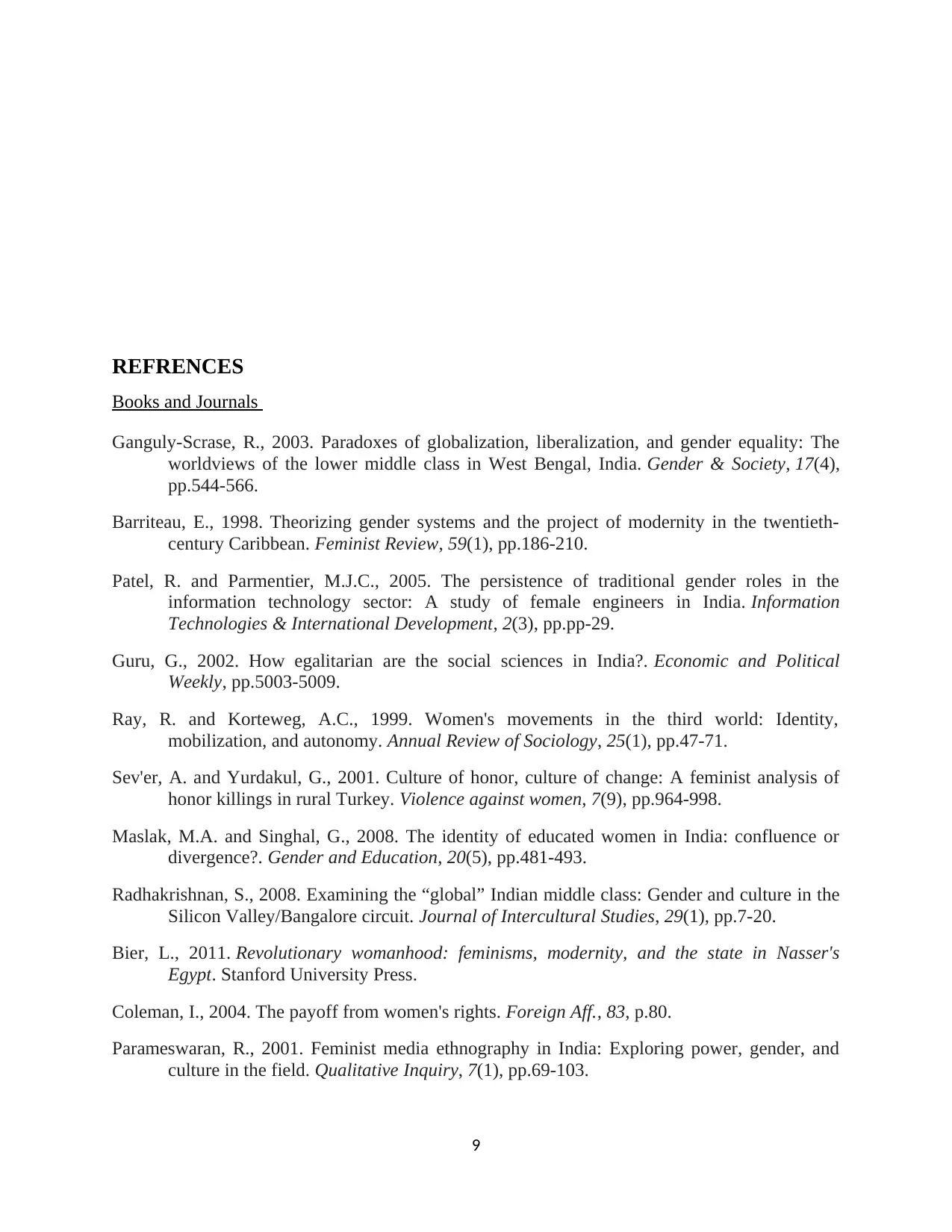
REFRENCES
Books and Journals
Ganguly-Scrase, R., 2003. Paradoxes of globalization, liberalization, and gender equality: The
worldviews of the lower middle class in West Bengal, India. Gender & Society, 17(4),
pp.544-566.
Barriteau, E., 1998. Theorizing gender systems and the project of modernity in the twentieth-
century Caribbean. Feminist Review, 59(1), pp.186-210.
Patel, R. and Parmentier, M.J.C., 2005. The persistence of traditional gender roles in the
information technology sector: A study of female engineers in India. Information
Technologies & International Development, 2(3), pp.pp-29.
Guru, G., 2002. How egalitarian are the social sciences in India?. Economic and Political
Weekly, pp.5003-5009.
Ray, R. and Korteweg, A.C., 1999. Women's movements in the third world: Identity,
mobilization, and autonomy. Annual Review of Sociology, 25(1), pp.47-71.
Sev'er, A. and Yurdakul, G., 2001. Culture of honor, culture of change: A feminist analysis of
honor killings in rural Turkey. Violence against women, 7(9), pp.964-998.
Maslak, M.A. and Singhal, G., 2008. The identity of educated women in India: confluence or
divergence?. Gender and Education, 20(5), pp.481-493.
Radhakrishnan, S., 2008. Examining the “global” Indian middle class: Gender and culture in the
Silicon Valley/Bangalore circuit. Journal of Intercultural Studies, 29(1), pp.7-20.
Bier, L., 2011. Revolutionary womanhood: feminisms, modernity, and the state in Nasser's
Egypt. Stanford University Press.
Coleman, I., 2004. The payoff from women's rights. Foreign Aff., 83, p.80.
Parameswaran, R., 2001. Feminist media ethnography in India: Exploring power, gender, and
culture in the field. Qualitative Inquiry, 7(1), pp.69-103.
9
Books and Journals
Ganguly-Scrase, R., 2003. Paradoxes of globalization, liberalization, and gender equality: The
worldviews of the lower middle class in West Bengal, India. Gender & Society, 17(4),
pp.544-566.
Barriteau, E., 1998. Theorizing gender systems and the project of modernity in the twentieth-
century Caribbean. Feminist Review, 59(1), pp.186-210.
Patel, R. and Parmentier, M.J.C., 2005. The persistence of traditional gender roles in the
information technology sector: A study of female engineers in India. Information
Technologies & International Development, 2(3), pp.pp-29.
Guru, G., 2002. How egalitarian are the social sciences in India?. Economic and Political
Weekly, pp.5003-5009.
Ray, R. and Korteweg, A.C., 1999. Women's movements in the third world: Identity,
mobilization, and autonomy. Annual Review of Sociology, 25(1), pp.47-71.
Sev'er, A. and Yurdakul, G., 2001. Culture of honor, culture of change: A feminist analysis of
honor killings in rural Turkey. Violence against women, 7(9), pp.964-998.
Maslak, M.A. and Singhal, G., 2008. The identity of educated women in India: confluence or
divergence?. Gender and Education, 20(5), pp.481-493.
Radhakrishnan, S., 2008. Examining the “global” Indian middle class: Gender and culture in the
Silicon Valley/Bangalore circuit. Journal of Intercultural Studies, 29(1), pp.7-20.
Bier, L., 2011. Revolutionary womanhood: feminisms, modernity, and the state in Nasser's
Egypt. Stanford University Press.
Coleman, I., 2004. The payoff from women's rights. Foreign Aff., 83, p.80.
Parameswaran, R., 2001. Feminist media ethnography in India: Exploring power, gender, and
culture in the field. Qualitative Inquiry, 7(1), pp.69-103.
9
⊘ This is a preview!⊘
Do you want full access?
Subscribe today to unlock all pages.

Trusted by 1+ million students worldwide
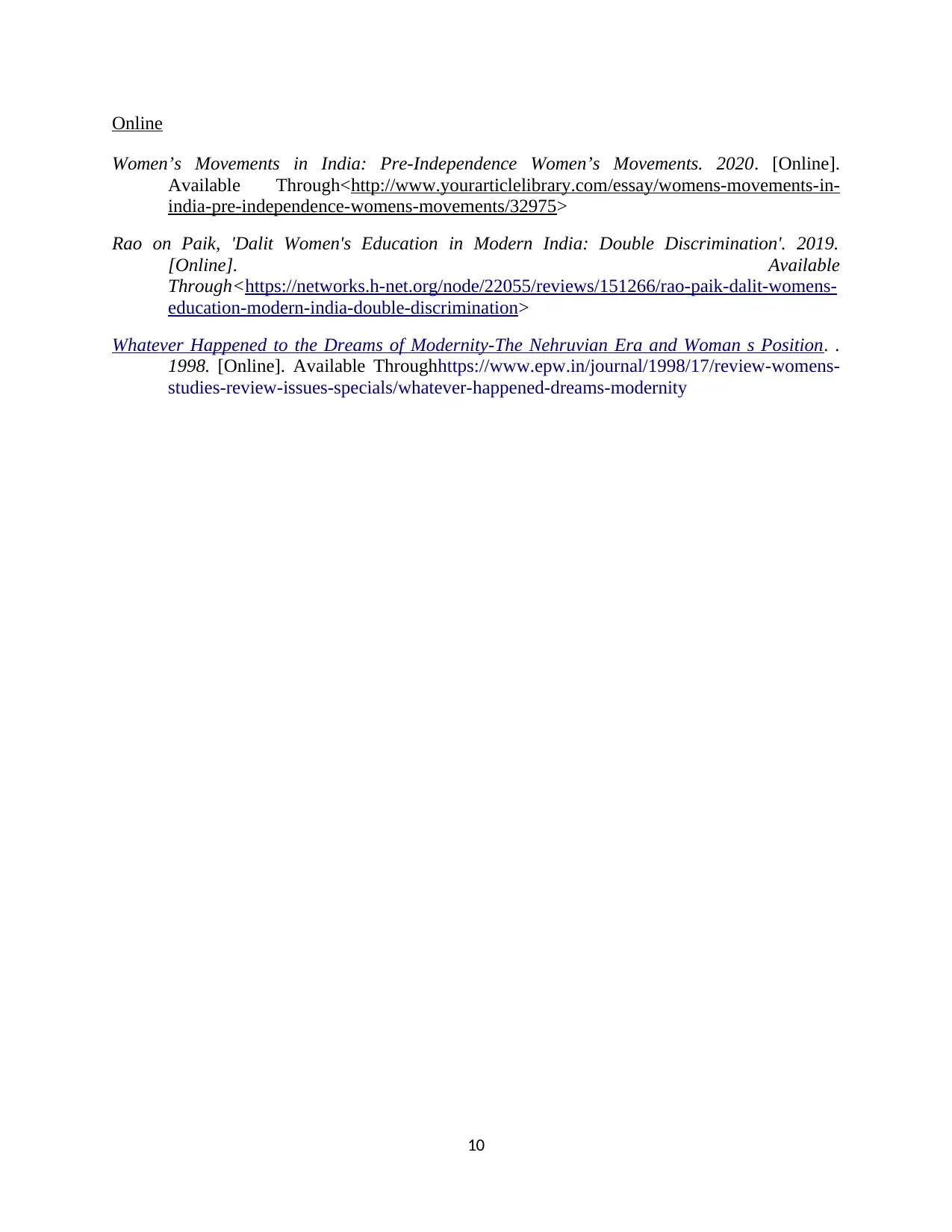
Online
Women’s Movements in India: Pre-Independence Women’s Movements. 2020. [Online].
Available Through<http://www.yourarticlelibrary.com/essay/womens-movements-in-
india-pre-independence-womens-movements/32975>
Rao on Paik, 'Dalit Women's Education in Modern India: Double Discrimination'. 2019.
[Online]. Available
Through<https://networks.h-net.org/node/22055/reviews/151266/rao-paik-dalit-womens-
education-modern-india-double-discrimination>
Whatever Happened to the Dreams of Modernity-The Nehruvian Era and Woman s Position. .
1998. [Online]. Available Throughhttps://www.epw.in/journal/1998/17/review-womens-
studies-review-issues-specials/whatever-happened-dreams-modernity
10
Women’s Movements in India: Pre-Independence Women’s Movements. 2020. [Online].
Available Through<http://www.yourarticlelibrary.com/essay/womens-movements-in-
india-pre-independence-womens-movements/32975>
Rao on Paik, 'Dalit Women's Education in Modern India: Double Discrimination'. 2019.
[Online]. Available
Through<https://networks.h-net.org/node/22055/reviews/151266/rao-paik-dalit-womens-
education-modern-india-double-discrimination>
Whatever Happened to the Dreams of Modernity-The Nehruvian Era and Woman s Position. .
1998. [Online]. Available Throughhttps://www.epw.in/journal/1998/17/review-womens-
studies-review-issues-specials/whatever-happened-dreams-modernity
10
1 out of 10
Related Documents
Your All-in-One AI-Powered Toolkit for Academic Success.
+13062052269
info@desklib.com
Available 24*7 on WhatsApp / Email
![[object Object]](/_next/static/media/star-bottom.7253800d.svg)
Unlock your academic potential
Copyright © 2020–2025 A2Z Services. All Rights Reserved. Developed and managed by ZUCOL.





